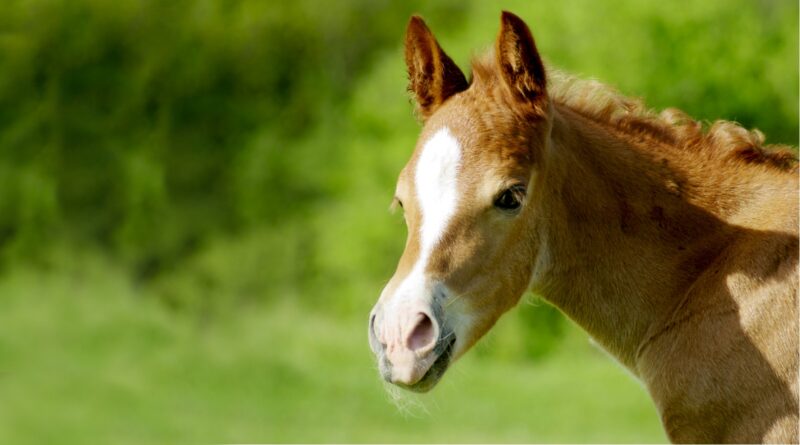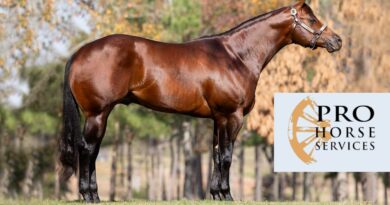Be Prepared- How to Perform Foal CPR
Courtesy AQHA
Cardiopulmonary resuscitation (CPR) is the restoration of spontaneous circulation and breathing and is used in cases of cardiopulmonary arrest, defined as sudden cessation of spontaneous and effective respiration and heartbeat.
This most often occurs in foals suffering from asphyxia or lack of oxygen before and during birth. Although you should call your veterinarian if you suspect a problem, following the “A-B-C-Ds” of resuscitation might help save your foal’s life.
“A” – Assessment/Airway
Following a normal delivery, observe the foal for the first 20 seconds to ensure he is breathing. Following a dystocia (difficult birth) or Caesarean section, dry the foal vigorously with his head lowered to help clear the fetal membranes and fluid from the nose so he can breathe (foals are obligate nose breathers; don’t worry about clearing the mouth). Avoid holding the foal upside down to try to increase drainage.
After a few initial gasps and within 30 seconds, a normal foal should be taking 60-80 breaths per minute. The heart rate should be 60-70 beats per minute. Foals that continue gasping for more than 30 seconds and have a heart rate less than 50 beats per minute, or no heartbeat, require immediate resuscitation.
“B” – Breathing
Intubation (through the nose or mouth into the trachea) is the best way to provide an airway and breathe for the foal. Only a veterinarian or trained veterinary technician should intubate. Until your vet arrives, you can use mouth-to-nose resuscitation or a mask resuscitator, although there is a risk of inflating the stomach using a mask resuscitator. Place the foal on its side on a firm, dry surface. To perform mouth-to-nose resuscitation extend the foal’s neck, make sure the nose is cleared, and hold off the down nostril with one hand while breathing into the up nostril. Deliver 10 to 20 breaths per minute; breathing too rapidly can be detrimental. Each breath should visibly expand the foal’s chest.
“C” – Circulation
After 30 seconds of breathing for the foal, reassess to determine if chest compressions are necessary – they aren’t required in all cases. If there is no heartbeat, it’s less than 40 beats per minute, or it’s less than 60 beats per minute and not increasing, chest compressions are indicated.
Place the foal on a firm, dry surface, position rolled towels or sandbags underneath the thorax, and put the resuscitator at the foal’s spine. Kneel or stand and place your hands on top of each other just behind the foal’s triceps at the highest point of the thorax. With the shoulders directly over the foal and the elbows locked, use the entire upper body to compress the thorax. Compress the entire thorax, not just the heart. There is a risk of fracturing ribs or lacerating the lungs with fractured ribs, but you shouldn’t avoid chest compressions.
Perform compressions at a rate of 80-120 per minute. Relieve the resuscitator every two to three minutes, if possible, because he/she will quickly become fatigued. Continue breathing for the foal throughout the compressions. If there is only one person available, give one breath for every 10 chest compressions.
“D” – Drugs
Always perform ventilation and compressions first. If there is no heartbeat after one minute of these activities, drug therapy might be indicated. However, human studies show prognosis is poor at this point and drugs might not help.
When to Stop
If you’ve performed CPR for 15 minutes with no response, success is unlikely. If the foal is responding, continue CPR. Once a foal’s heartbeat is faster than 60 beats per minute, you can discontinue chest compressions. Once he’s taking more than 16 spontaneous breaths per minute and has a heart rate of 60 beats per minute or faster, you can stop breathing for the foal.
After resuscitation, foals require intensive care and monitoring, as they have suffered a hypoxic event and might suffer cardiac arrest. They should be referred to a clinic or hospital for such care.
Ask your veterinarian to help you assemble a “crash cart” for the barn.
— Dr. Laura Javsicas, member of the American Association of Equine Practitioners
*AQHA and the provider of this information are not liable for the inherent risks of equine activities. We always recommend consulting a qualified veterinarian and/or an AQHA Professional Horseman.





